 The code requirements that apply to electrified hardware and access control can be difficult to interpret, although code changes approved through the last few editions of the model codes have helped to clarify the intent. This page includes questions to help identify which code section applies to a particular type of access control opening, a short summary of each of the electrified hardware applications, and links to additional information about each type.
The code requirements that apply to electrified hardware and access control can be difficult to interpret, although code changes approved through the last few editions of the model codes have helped to clarify the intent. This page includes questions to help identify which code section applies to a particular type of access control opening, a short summary of each of the electrified hardware applications, and links to additional information about each type.
Special Locking Arrangements are electrified locking systems that may affect egress, such as delayed egress or controlled egress locks. Although there are quite a few code sections that apply to these applications, the majority of doors with access control readers are not considered special locking arrangements, because the hardware allows free and immediate egress – independent of the access control system. These systems that allow free egress via mechanical operation of the door hardware are considered “normal locking arrangements” and are subject to the same egress requirements as doors with standard mechanical hardware.
The model codes that we most often refer to for information related to access control systems are the International Building Code (IBC), International Fire Code (IFC), and NFPA 101 – Life Safety Code. The requirements of the I-Codes and the NFPA codes are similar, although there are some variations. There may also be state-specific code modifications that apply to these systems. Detailed information about the requirements can be found by referring directly to the adopted codes.
The following questions will help to determine which model code section applies to your electrified hardware application:
~~~

Under normal operation, a delayed egress lock delays egress for 15 seconds after an attempt to exit is made.
Type 1) Does the electrified hardware delay egress for 15 seconds (or 30 seconds) to deter unauthorized use of the door?
If yes, this is a delayed egress locking system. Under normal operation, this hardware delays egress for 15 seconds, or 30 seconds where approved by the Authority Having Jurisdiction (AHJ). This hardware is most commonly used to deter unauthorized use of an exit, helping to prevent theft or elopement. The 15-second timer is actuated by an attempt to exit, when a force of not more than 15 pounds is applied for up to 3 seconds. Immediate egress is required (no delay) upon activation of the fire alarm or sprinkler system, and upon power failure. An audible alarm and signage are also required.
Note: A change to the 2018 edition of the I-Codes permits the use of delayed egress locks on doors serving educational classrooms with an occupant load of less than 50 people. This application may be helpful to deter elopement of young children and students with special needs.
For detailed requirements on hardware that delays egress for 15 seconds (or 30 seconds where approved by the AHJ), refer to IBC/IFC 2021: 1010.2.13; 2024: 1010.2.12 – Delayed Egress / NFPA 101 – 2021, 2024: 7.2.1.6.1 – Delayed Egress Electrical Locking Systems.
~~~
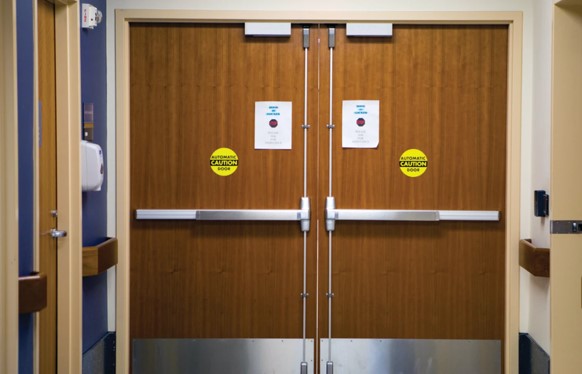
Controlled egress locks prohibit egress until evacuation is needed, and are only allowed in certain types of health care units.
Type 2) Is the electrified hardware used to control egress indefinitely in a memory care facility or other health care unit where patients require containment for their security or safety?
This application is called a controlled egress lock, which is only allowed in health care units where the clinical needs of patients require their containment to prevent them from leaving the facility unaccompanied; it is not allowed by the model codes in other types of occupancies. In health care units where controlled egress locks are installed, all clinical staff must carry the keys, codes, or other credentials required to operate the locks, and the unlocking procedures must be part of the facility’s emergency plan. The model codes include automatic release requirements that apply to some occupancy types.
For detailed requirements on electrified hardware that prevents egress from a health care facility until evacuation is needed, refer to IBC/IFC 2021: 1010.2.14; 2024: 1010.2.13 – Controlled Egress Doors in Groups I-1 and I-2 / NFPA 101 2021, 2024: 18/19.2.2.2.5 (New and Existing Health Care), also refer to 20/21.1.3.6 (New and Existing Ambulatory Health Care).
~~~

Other types of electrified locks may be released by a sensor above the door, but the most common lock used in this application is an electromagnetic lock.
Type 3) Is the lock an electromagnetic lock released by a sensor above the door?
There are two code sections that typically apply to electromagnetic locks, depending on the type of release devices installed (see also Type 4). An electromagnetic lock consists of an electromagnet in a housing mounted on the door frame, and a steel armature mounted on the door. When power is applied, the magnet bonds to the armature and locks the door. Without the release devices mandated by the model codes, these locks would not allow egress when they are powered, so it’s crucial to understand what is required by each of the two applicable code sections.
One method of releasing a mag-lock is with a sensor above the door on the egress side that detects an approaching occupant and unlocks the lock. In past editions of the model codes, the section addressing this application was called Access Controlled Egress Doors, leading some to believe that this section was applicable to every door equipped with an access control reader. That was not the intent of the codes, so the section titles were changed to indicate that the sections apply only to locks released by a sensor – not to every door with access control. Note that some sensors mounted above the door are used by the security system to signal that someone has exited and may not be related to the locking or unlocking of the door (this code section does not apply to those sensors).
For detailed requirements on electromagnetic locks released by a sensor, refer to IBC/IFC 2021: 1010.2.12; 2024: 1010.2.11 – Sensor Release of Electrically Locked Egress Doors / NFPA 101 2021, 2024: 7.2.1.6.2 – Sensor-Release of Electrical Locking Systems.
~~~
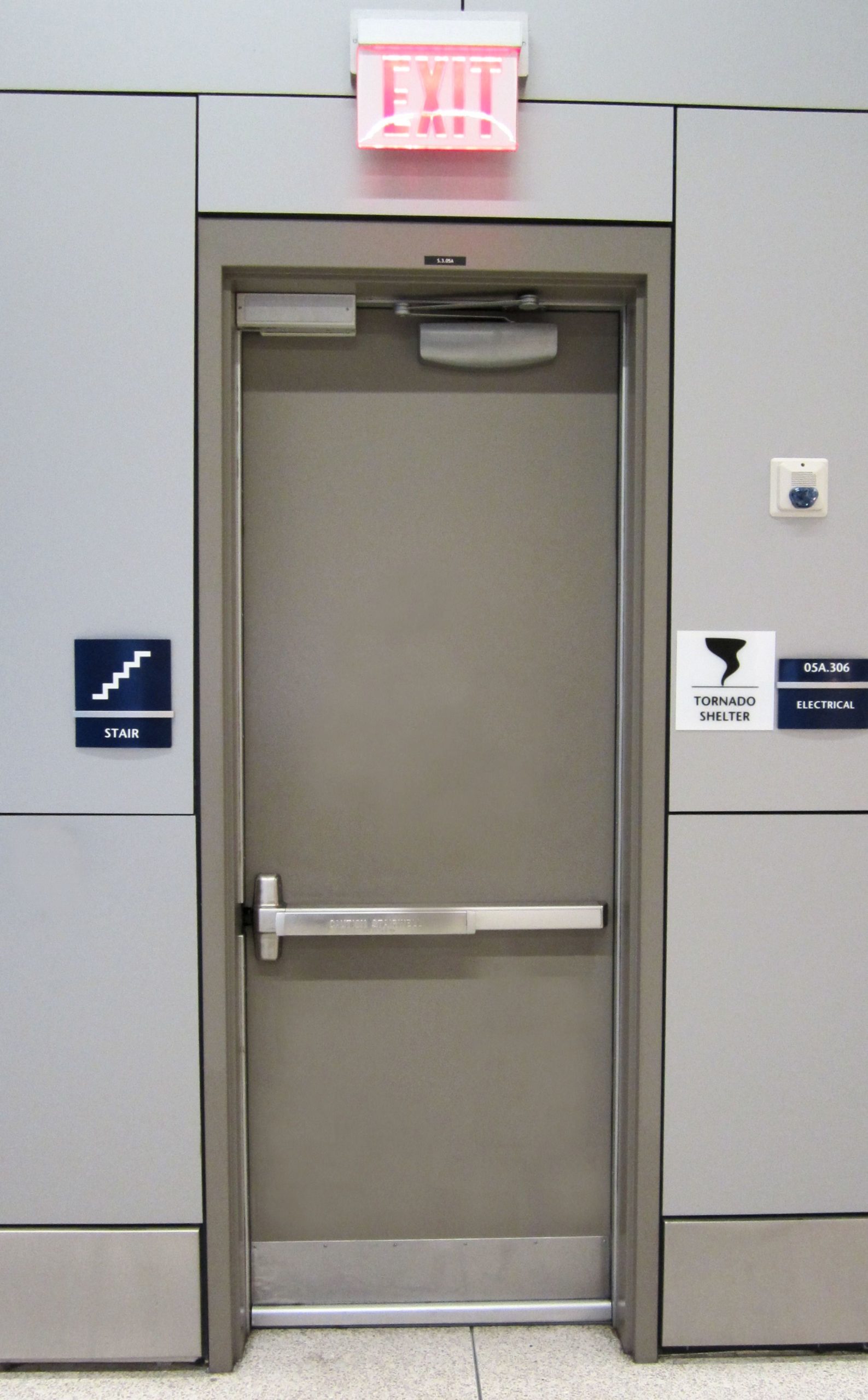
The other common application for electromagnetic locks is where a switch in the hardware mounted on the door releases the lock for egress.
Type 4) Is the lock an electromagnetic lock released by a switch in the door-mounted hardware?
Another method for releasing an electromagnetic lock is via a switch in the door-mounted hardware. Instead of a sensor above the door, these systems use an electronic switch in the lever handle, panic hardware, or electronic touch-sensor bar to release the mag-lock for egress. This switch is often called a request-to-exit switch or RX/REX switch.
This section would not apply to a door with an access control reader where the mechanical lockset or panic hardware allows free egress. It is only applicable to systems where a switch in the door-mounted hardware releases an electrified lock – typically a mag-lock.
For detailed requirements on electromagnetic locks released by a switch in the door-mounted hardware, refer to IBC/IFC-2021: 1010.2.11 – Door Hardware Release of Electrically Locked Egress Doors / NFPA 101-2021: 7.2.1.6.3 – Door Hardware Release of Electrically Locked Egress Door Assemblies.
~~~
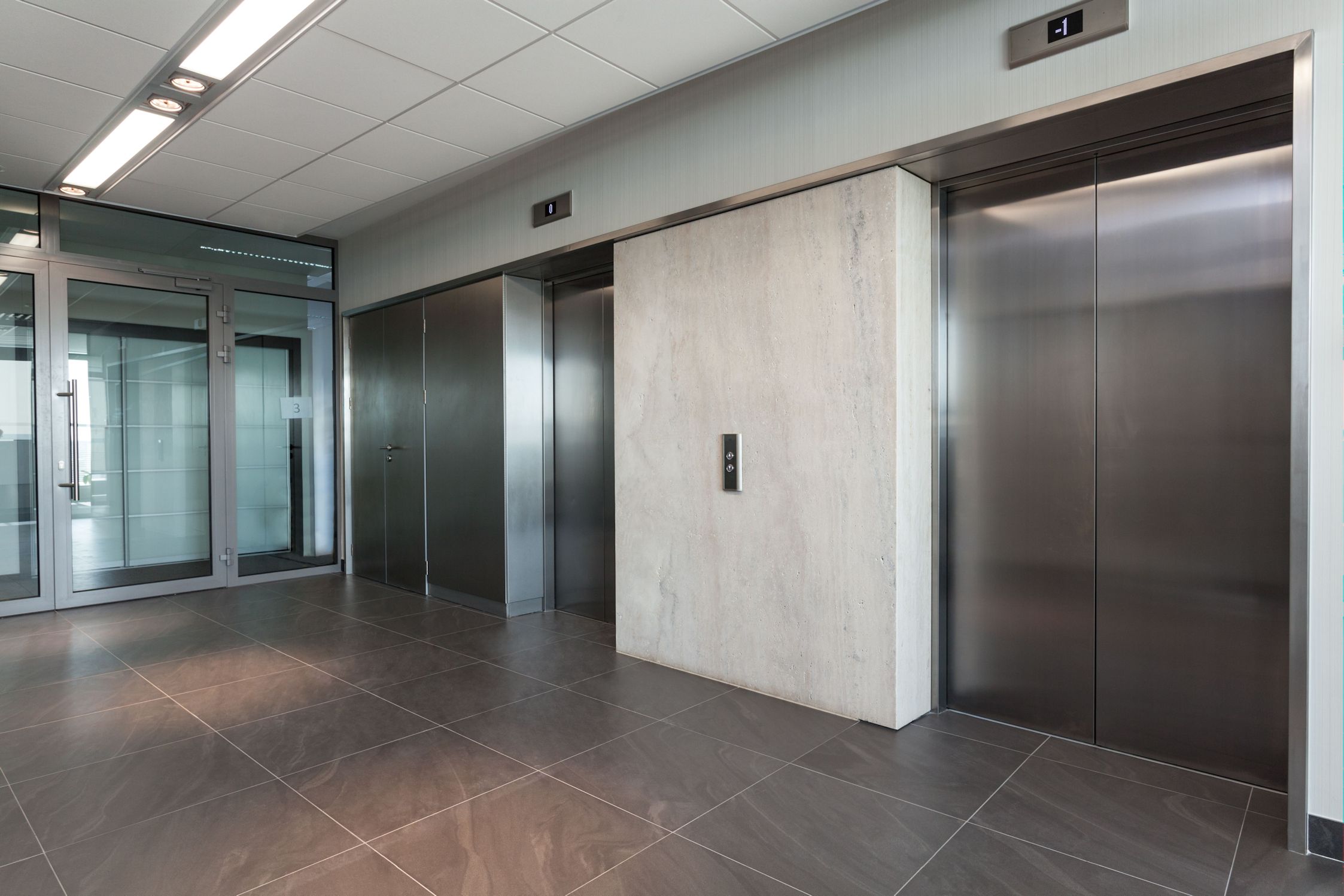
Prior to the 2024 editions of the I-Codes, these codes did not include a section addressing the electric locking of elevator lobby doors, but a new section has been added.
Type 5) Does the door serve an elevator lobby that does not have direct access to an exit stairwell?
The Life Safety Code permits electrified locking of elevator lobby doors if all of the criteria stated in the code are met. The lock must unlock automatically upon actuation of the sprinkler system or fire alarm system (except when the system is initiated by a manual fire alarm box) and upon loss of power to the lock. A two-way communication system must be installed in the elevator lobby to allow a building occupant to call for help.
Prior to the 2024 editions, the IBC and IFC required elevator lobbies to have at least one door that leads to an exit, providing code-compliant egress. In the 2024 editions, a new section was added to the I-Codes that addresses the use of fail safe locks on these doors. This section is similar to the requirements found in the Life Safety Code, but not exactly the same.
For detailed requirements on egress doors serving elevator lobbies, refer to IBC 2024: 1010.2.14 – Elevator lobby exit access doors / NFPA 101 2021, 2024: 7.2.1.6.4 – Elevator Lobby Exit Access Door Assemblies Locking.
~~~
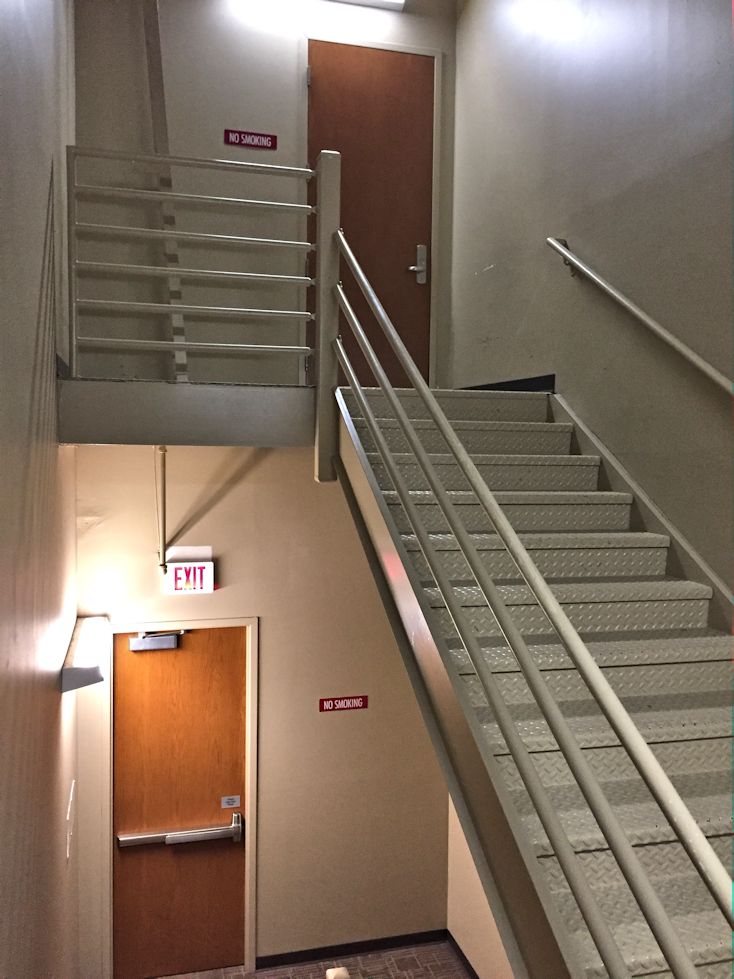
If an interior door leading to a stairwell is locked on the stair side, preventing access from the stairwell to a tenant floor, the IBC requires remote unlocking capability regardless of the number of floors served by the stair.
Type 6) Is the door an interior fire door assembly leading to a stairwell, where the lever handle on the stair side of the door is typically locked?
In buildings where stairwell doors are locked (or lockable) on the stair side, the stairwell reentry requirements address the means of allowing reentry back into the building if the stairwell becomes compromised during a fire. This ensures that building occupants can leave the stairwell and find another exit, or shelter in place and wait for rescue. The unlocked stair doors also allow firefighters to access each floor. NFPA 101 and the I-Codes differ in how stairwell reentry is addressed.
While the Life Safety Code allows some stairwell doors to be mechanically locked on the stair side with other doors allowing reentry, the IBC and IFC require all interior stairwell doors to be capable of remote unlocking from a switch at the fire command center or other approved location. The 2024 editions of the I-Codes clarified that these doors must also be unlocked on the stair side upon activation of the fire alarm/sprinkler system and upon loss of power. For high-rise buildings, a stairway communication system is required when the doors are electrically locked on the stair side.
Electric strikes must not be used for the purpose of stairwell reentry, as electric strikes for fire doors must be fail secure. The hardware typically used for this application is a fail safe electromechanical lockset, fail safe electrified lever trim for fire exit hardware, or an electromagnetic lock with a passage set.
Note that some stairwell doors may have hardware providing reentry on the stair side, in combination with another type of electrified hardware, such as delayed egress or controlled egress, on the egress side. These doors must meet the requirements of all applicable sections.
For detailed requirements on the reentry requirements for locks on the stair side of stairwell doors, refer to IBC/IFC 2021: 1010.2.7; 2024: 1010.2.6 – Stairway Doors and 403.5.3 – Stairway Door Operation / NFPA 101 2021, 2024: 7.2.1.5.7 – Stair Enclosure Re-entry.
~~~
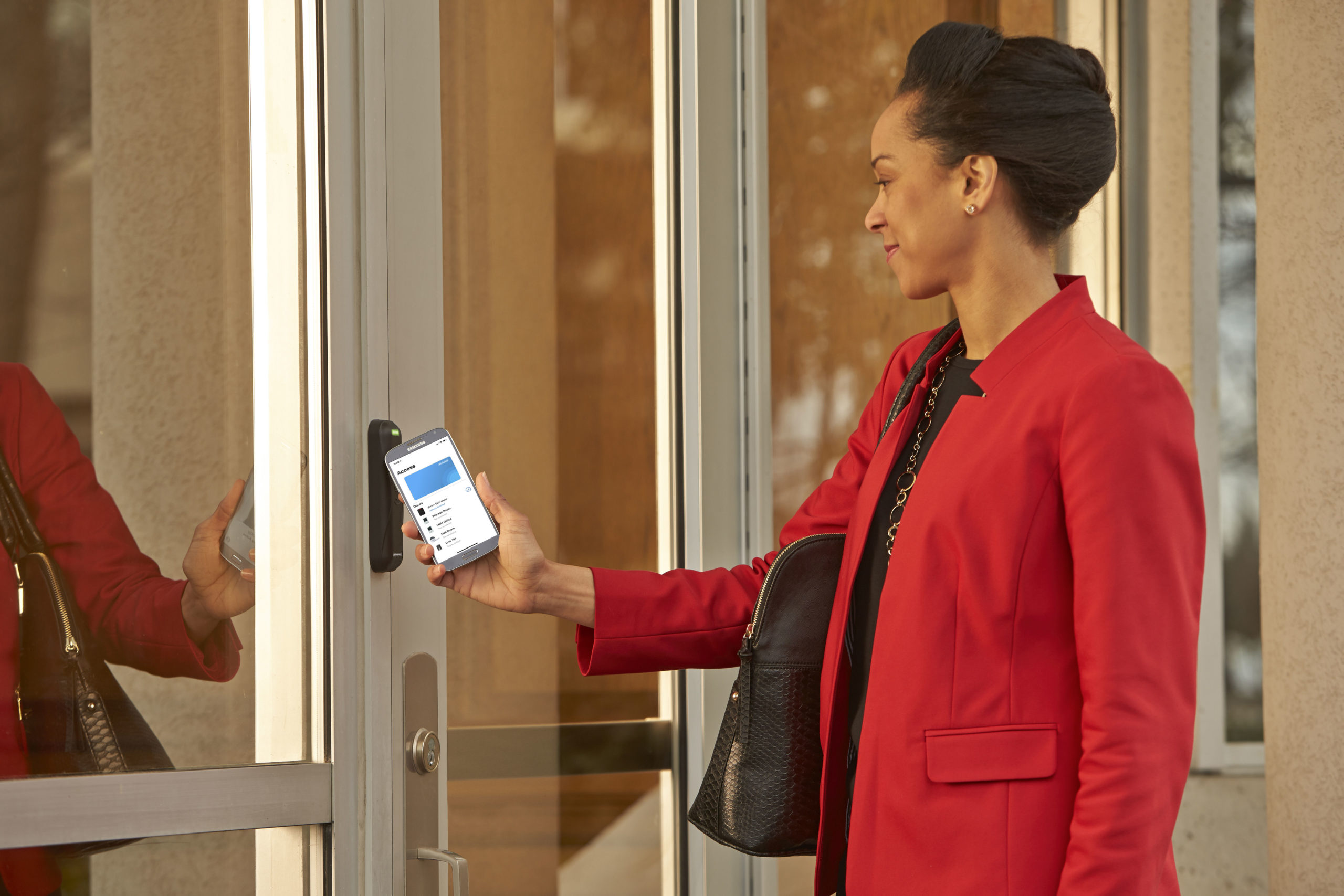
If a door with electrified hardware allows free egress via mechanical use of the door hardware, it is not considered a special locking arrangement.
Type 7) Is there an access control reader on the outside, that controls access while the door hardware provides free egress at all times?
If yes, it’s likely that the doors in question are not considered one of the “special locking arrangements.” The most common type of access control system includes a reader that controls access only – and does not impede egress in any way. The lever handle or panic hardware on the egress side allows egress the same way a door with standard mechanical hardware and key access would.
Prior to the 2024 mode codes, there was not a separate code section specific to access control systems that control access but do not affect egress. Because these systems are not considered special locking arrangements, they must comply with the code requirements for “normal locking arrangements” – the same sections that would apply to doors with mechanical hardware.
A change was made to the 2024 I-Codes which clarifies that electrified hardware can EITHER meet one of the special locking arrangements sections, OR “shall be readily openable from the egress side without the use of a key or special knowledge or effort.” Most doors with access control readers are readily openable from the egress side via the mechanical hardware, and in this case, the requirements for special locking arrangements do not apply.
In the 2024 edition of NFPA 101, a note was added in Annex A, related to Section 7.2.1.5.3 Latch-Release Devices. This is the section stating that door hardware must have an obvious method of operation that is readily operated under all lighting conditions. In part, the annex note states: Also common are electrical access control systems such as an electric lock or electric strike controlled by the input of a card reader or keypad. On the egress side of these doors, the lever-operated hardware, panic hardware, or fire-exit hardware must provide for immediate and unimpeded egress. This note clarifies that hardware meeting the requirements of the latch release section might have electrified hardware controlling access.
These doors with normal locking arrangements must be operable for egress with no key, tool, special knowledge or effort, and with no tight grasping, pinching, or twisting of the wrist. Operable hardware must be mounted between 34 and 48 inches above the floor (some state codes are more restrictive on this), and one releasing operation must unlatch the door (with a few exceptions). Hardware for these systems is not required by the model codes to be listed to UL 294 – Standard for Access Control System Units or to UL 1034 – Standard for Burglary-Resistant Electric Locking Mechanisms.
The IBC/IFC Commentaries and the NFPA 101 Handbook include information which further clarifies that the sections on special locking arrangements do not apply to electrified hardware that allows free egress at all times – independent of the access control system.
For detailed requirements on egress through doors with “normal locking arrangements”, refer to IBC/IFC – 2024: 1010.2.9 – Monitored or recorded egress, and access control systems / NFPA 101 2024: 7.2.1.5.3/A7.2.1.5.3 – Latch-Release Devices.
~~~
Conclusion
When considering which code requirements must be followed, first identify which category the hardware falls into, and then refer to the applicable code section(s). This summary is not intended to provide complete information about the types of electrified hardware referenced. More detailed information can be found in the code sections listed with each application. Keep in mind that state or local requirements may differ from those of the IBC/IFC or NFPA 101, so it’s important to be aware of the codes in your project’s jurisdiction. Refer to the adopted codes for the detailed code requirements, and contact the AHJ if you need assistance.
~~~
Additional Resources
The following whiteboard animation videos address electrified hardware:
- Intro to Door Hardware – Electricity Basics
- Intro to Electromechanical Locking Hardware
- Fail Secure vs. Fail Safe
- Decoded: Code Requirements for Electromagnetic Locks
- Decoded: Controlled Egress vs. Delayed Egress
- Decoded: Stairwell Reentry
On the webinars page of this site, there are several webinar recordings related to electrified hardware, including:
- Introduction to the Code Requirements for Electrified Hardware
- Decoded: Delayed Egress and Controlled Egress Locking Systems
- Decoded: 2021 Model Code Update
- Crash Course in Codes
For information on recent code changes related to door openings, refer to these Decoded articles:
- Model Code Update on Swinging Door Openings
- What’s Next? Approved changes to the 2024 IBC affecting electrified hardware
- 2021 Model Code Update – What’s New?
The Allegion Code Reference Guide includes summaries of the code requirements applicable to door openings, and the referenced paragraph numbers from past editions of the model codes. The guide can be downloaded here.
There is a crossword puzzle about codes related to electrified hardware here, if you want to test your knowledge. 🙂
If you have questions about the operation of fail safe hardware vs. fail secure hardware, and when each is recommended or required, refer to this Decoded article.
And COMING SOON! A new section addressing interlocks (AKA mantraps or control vestibules) has been approved for the 2027 I-Codes. Fingers crossed for the 2027 NFPA codes as well.
